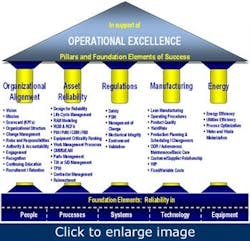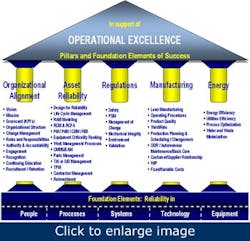This is the first of the “Road to Reliability” series of articles that will discuss reliability and maintenance from both fundamental and leading practices perspectives.
Many factors affect and contribute to operational excellence, but reliability is its core underpinning. Companies can draw on a wide-ranging group of lean or world-class manufacturing techniques and tools, but if reliability is lacking, so will plant’s performance. An operationally excellent organization can start its equipment on demand, complete the production run in a quality, timely manner based on design capability and shut down without mishap. This is done in a safe, cost-effective manner, compliant with regulatory requirements. Operational excellence requires excellence in reliability.
[pullquote]Many definitions of operational excellence and world-class reliability exist. Anybody who has worked in the field for a significant time, whether a consultant, an academic or a practitioner, has likely developed a personal perspective and understanding of operational excellence. Individuals and groups can argue ad infinitum or ad nauseam why their model is correct, while others are deficient. But it’s not generally a question of being right or wrong, as most definitions have a degree of commonality. Purists might want to debate finer points, and that’s great. Heated but constructive discussions can generate better understanding of, and commitment to, a particular vision of operational excellence. The danger is that some individuals and organizations debate endlessly, losing focus on the need to actually start making the operational improvements.
It’s critical that its employees share a common vision. Personnel should debate what makes up operational excellence, but once the debate ends, they need to rally around the accepted vision and strive wholeheartedly toward its attainment.
For organizations that haven’t yet defined the key elements or components of an operational excellence initiative, a sample is provided below. We’re not claiming that this is “the” optimal model of operational excellence, but it is a template that can be used in any initial discussions of what they believe the model should be for them. Depending on the industry and the economic environment, individual model elements might have greater or lesser priority.
Five base or foundational elements in this model are people, processes, systems, technology and equipment. Reliability in, and integration of, each of these elements lays the foundation for success. Although overlap exists among these elements, that overlap also serves as the potential link of one to another. So what does it mean to have reliability in these areas?
- People: Reliable people implies a motivated, educated workforce that consistently carries out their defined roles and responsibility, while being accountable for results. They work together as a team, backstopping one another when necessary, with egos subjugated.
- Processes: Reliable processes are well defined, appropriate production and business (work management) processes in which the workforce is educated and trained. The processes are revalidated or updated on a continuous basis, and training is reinforced periodically in both the classroom and on the floor.
- Systems: Reliable systems are computerized systems that mirror and support the business processes. The systems are designed and configured to support business objectives rather than the reverse. They don’t just provide data, but also generate information that is ready for analysis, decision-making or action-taking.
- Technology: Reliable technology means state-of-the-art tools to feed your systems with timely data or provide data analysis leading to prevention or resolution of problems.
- Equipment: Reliable equipment actually is an outcome of the four items above. But it also is a result of the selection process when the unit is built, before people, systems, processes and technology to operate and maintain it are in place.
So, to summarize: If we install “fit for purpose” equipment, operate and maintain it with a motivated and educated workforce, support it with designed business processes, systems and technology, we have the potential to achieve operational excellence.
Although industry is becoming more automated, people still are the critical factor in an organization’s success. In fact, one could argue that their importance is even greater as personnel numbers shrink. It’s more power in fewer people’s hands. Automation can do great things, but it’s people that design, install, program, and operate the equipment and systems.
Along with the five foundation elements, the proposed operational excellence model includes five pillars.
- Organizational alignment: Having an organization structured or set up to succeed, with personnel moving together in concert toward agreed upon and understood goals and objectives. Several items in this pillar (i.e. vision and mission) might be considered “soft” or “fluff” items by some people. If not applied correctly, that can be the case. Bountiful examples of “feel good” or politically correct mission statements adorn the walls of manufacturing sites, yet have minimal effect on the decision-making and actions of the employees. On the other hand, numerous mission statements have captured the imagination of people. Other items in the organizational alignment pillar might appear more substantial, such as the scorecard (KPIs). Yet they also might have either significant or minimal effect on an organization. It’s not a question of whether an organization has these items, it’s a question of how effectively they’re being applied. That statement holds true for the items in all five pillars.
- Asset reliability: Strong reliability and maintenance practices are recognized, at least verbally, as being critical to an organization’s success. Yet, that verbal recognition frequently doesn’t translate into action. Or, if it does, people attack overall reliability issues without laying out an intelligent plan. These items and selected items from other pillars will be the subject of subsequent articles in this series.
- Regulations or compliance: If you want to be in business, you need to be in compliance. Safety and the environment can’t be compromised, and standards in these areas are only going to become more stringent. Most importantly, we want to safeguard our personnel and communities. Companies face large fines, the possibility of executives going to jail or losing their license to operate if they neglect these areas.
- Manufacturing: Clearly, manufacturing processes and methods contribute mightily to operational excellence. Flexibility and speed are crucial to winning customer orders, but it has to be done in a cost-effective, quality manner. Many companies have embraced the concept of lean manufacturing, which actually can serve as an umbrella for many of the items listed in the manufacturing pillar, or even the other pillars.
- Energy: Several years ago, energy likely would not have been considered a pillar of operational excellence. With the growing focus on being green, as well as considering the costs associated with energy, it deserves inclusion. More products and services are being directed toward optimizing the purchase and use of energy, and companies are now adding “energy czars” to their organizational charts. In the future, you’ll not be able to consider yourself operationally excellent if you haven’t addressed the energy opportunities.
This is one of many potential theoretical models of operational excellence. Obviously, you can include numerous other items in the pillars, or you could even add other pillars. Or, you could argue that any of the pillars is an underpinning or foundation element for the other four. In reality, it’s the interrelationship or integration among them that drives operational excellence. For our purposes, these five will serve as a starting point for discussion and will be addressed in subsequent articles.
Andy Ginder, vice president, ABB Reliability Consulting, may be reached at [email protected]

